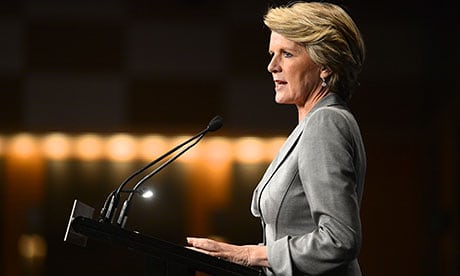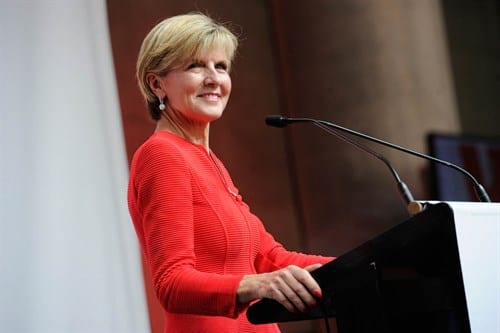Leadership strategies for women
Who would have thought that Julie Bishop would experience unconscious bias in her workplace — yet she recently described her time in Tony Abbott’s cabinet as “lonely”.
One could imagine that sitting in a cabinet meeting full of A-type personalities means that there is lots of grand standing, posturing and one-upmanship — tiring at the best of times, exhausting when it is just the modus operandi. No emotional intelligence, empathy or humility. Speak or be spoken over.
Is this the same in every boardroom in the country that has little to no diversity?
I would like to think that we have evolved and that life in an Australian boardroom is better than it has ever been. However experience does not support this.
That is why Julie Bishop’s insights add a valuable contribution to the conversation, clearly demonstrating why we need more than tokenism in a boardroom.

Leadership diversity is essential to represent the audience, customers, constituents — that is, the stakeholders.
I think one of the great challenges of having a sole “token” female voice is that often people believe that single female’s view represents all women, that women have one homogenous viewpoint. Yet we all know that if you put five women together to debate any topic from immigration to tax reform, we will have five (if not more) different opinions. It is definitely not the case that if you have one woman you have the view of all women represented — sounds obvious.
One of the things I love about being on the panel of Channel Ten’s Shark Tank, and being a role model for all people with business aspirations is that Janine Allis (another of the five panellists) and I very rarely see eye-to-eye — or agree in our approach to the problem at hand.
We see things differently, we ask different questions and as such, people can’t just say, “this is the women’s business”, “that’s the female questions”. This gives variety to the conversation — a different perspective.
I often remark how I might ask a question, about a particular topic and then I notice that one of the men will bring up a similar topic down the track. Bishop also spoke of how she would have an idea and only a few minutes later someone else (a male) would adopt it as their own.
But if we consider how our minds are hardwired to operate, the subtle placement of ideas can percolate and then resurface later (like the magician able to influence your “random” selection of a number by priming you with the number he wants you to say).
I would argue this is not just a gender issue but a natural progression of the conversation. It can be frustrating at times but there is no reason we can’t acknowledge and remind people it was in fact the idea we had just been speaking about — or thank the person for continuing with the idea you had spoken about earlier.
There are other strategies that we can put in place.
How to have your voice heard
First of all we have to not be triggered by the “emotion” of not being heard — and we have to be an observer of what is happening.
It is really important that we do speak up — silently fuming that you did not “get a turn” is of no help. I know many women in a boardroom who won’t speak for the first three meetings until they’re absolutely certain they know the lay of the land, the politics, the numbers, the strategy and the plan.
Waiting for perfection does not really serve us when our role is to be curious and have an inquiring mind.
Too often though I hear women almost apologise when they want to contribute (like a “good girl” waiting for her turn in class). Please, please, please don’t preface your question with “this might be a silly question but… ”, because as soon as you do, it becomes a silly question.
The words you use are very important in your leadership strategies. Use powerful words with determination and commitment, even lower your voice an octave to create some gravitas in what you have to say.
It is sad to say but the truth is that a squeaky, sweet voice will not give you the cut through that you need to hold a room of A type men who are used to winning.

I am so embarrassed to admit that I saw myself doing just this on the first season of Shark Tank. Primarily Steve, but the other men too, would be rapid fire with questions, I would sit back and wait my turn — which sometimes just never came. And I would observe that my voice would often get a bit squeaky… argh!
I learned to speak up, speak slowly, drop my voice and always speak with conviction. I got a better outcome.
It is appalling to think that the cabinet is not representative of the people it serves. However perhaps it is the political games that are played to get a seat in that room that deters many women from saying: “I absolutely need to be there, and I will play the games needed so I get to do that job.”
I for one hate playing these games, finding allies prior to meetings, creating pathways — I just want to get on and do the job. But the risk of being outnumbered by men is likely to limit rigorous and robust discussion — like-minded people from similar backgrounds can easily slip into “group think”.
So you need to find at least one ally in the room. Finding common ground before a meeting can be very beneficial so you can throw to someone else and further your argument. Good discussion always does take energy, thought, strategy and consistency.
It’s hard to be the lone voice in the wilderness so finding that ally can be a very valuable strategy. But be agile — there will be different people for different topics… it is not a one size fits all approach.
And there is not one finite definition of success either. To be successful in a boardroom is to have made a valid contribution to the conversation, not just getting your own way.
Your way might not be the best — or only — way. Without innovation a business is unlikely to grow. I would say an imbalance creates an environment where you’re not necessarily getting different voices, viewpoints and robust discussion.
Group think is the worst thing that can happen in a board. And without diversity it is far more likely to happen.
Recently I joined a board where they were all accountants and lawyers. The reason I was invited to be on the board was not because I was a woman — there were other women on the board — but because my background and my experience in small business was so materially different to everyone else there that I was bound to offer a very different perspective.
It isn’t about diversity of gender, but diversity of experience — that is how we can shift the tokenism.

Diversity of background will ultimately deliver diversity of ideas and experience, not to mention age. A good friend of mine, Holly Ransom, who is in her 20s sits on several boards and she offers such a different viewpoint than perhaps someone of my age and I am sure the boards she sits on get great value from that.
To move away from tokenism we need to move away from thinking “I’m trying to fill a gender quota” to thinking “I’m trying to have a different conversation between people of diverse backgrounds that represents my stakeholders”.
I’m pleased that Bishop spoke about her experience. It demonstrates that in the “highest” boardroom in the land we still have not got it right. But if we don’t speak about it then we will never be able to shift it.
This article first appeared nationally in News Corp, in print and online.
Featured images from Ruby Connection.




Michelle Young says
Thank you for this article, it has addressed something that in the past was basically a taboo subject. I have been there with the mousy little voice and left feeling frustrated that I didn’t get the point across about my business.
Time to stand up and be heard, thank you Naomi, kind regards, Michelle.